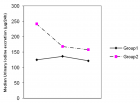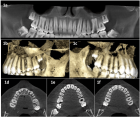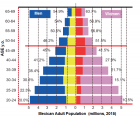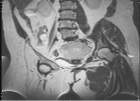Abstract
Research Article
Iodine status and thyroid parameters of pregnant women living in an iodine sufficient area
Fereidoun Azizi*, Hossein Delshad, Parvin Mirmiran, Ladan Mehran and Maryam Tohidi
Published: 03 February, 2021 | Volume 5 - Issue 1 | Pages: 001-006
During the last few decades painstaking efforts have been made to eliminate iodine deficiency throughout the world. Todays in regions where dietary iodine intake is adequate or borderline, the main focus is increasing dietary iodine supply in the target population during pregnancy and the first years of life.
Objective: The aim of this study was to obtain longitudinal data on urinary iodine excretion and the changes of maternal thyroid parameters in two groups of healthy women with mild-to-moderate iodine deficiency and iodine sufficiency residing in an iodine replete area of Tehran capital city of IR Iran, for more than one decade.
Research designs and methods: The present study is part of a cohort study, investigating the relative influences of iodine intake on thyroid size and function of mothers and their infants during and after pregnancy. A total of 500 pregnant women enrolled from two mother-child health care centers and was divided into group I, with median urinary iodine excretion (MUIE) < 150 µg/L, and group II with MUIE ≥ 150 µg/L. Sonographic thyroid volume measurement, urinary iodine excretion and thyroid function tests were measured sequentially in all pregnant women during the three trimesters (T) of pregnancy.
Results: The mean ± SD age of the participants was 25.1 ± 5.1 years. The MUIE in group I and II in the first, second and third trimester were 123 and 250 µg/L, 127 and 166 µg/L, 120 and 150 µg/L, respectively. The MUIE in the third trimester of pregnancy in group I did not differ significantly from the values in the first and second trimesters (p = 0.67), but it did decline significantly in group II (p < 0.001). The median thyroid volume of subjects, in the first, second and third trimesters were 7.8, 8.2 and 8.1 ml in group I and 7.5, 8.0 and 8.4 ml in group II, respectively. No difference in thyroid volume was found between two groups in each of the three trimesters of pregnancy (p > 0.05). The mean (± SD) TSH concentration of subjects in first, second and third trimester was 2.3(± 2.6), 2.1(± 1.8), 2.3(± 1.7) mIU/L in group I and 2.1(± 3.1), 2.1(± 1.8) and 2.0(± 1.3) mIU/L in group II, respectively. The trend of TSH rising in group I was 26.7% and in group II it was 13.3%. The mean TSH value in three trimesters did not differ significantly in either groups (p > 0.05). The mean (± SD) total T4 concentrations of subjects in first, second and third trimesters were 13.2(± 3.4), 13.8(± 3.3), 13.0(± 2.9) µg/dl in group I and 13.1(± 3.2), 13.7(± 2.9), 13.4(± 3.2) µg/dl in group II, respectively. The mean total T4 value in three trimesters did not differ significantly in either groups (p > 0.05). There was no correlation between the thyroid volume and three observed parameters (UIE, total T4 and TSH) during the pregnancy in either groups.
Conclusion: Even in areas with well-established universal salt iodization program, pregnancy could be a risk of having iodine deficiency and systematic dietary fortification needs to be implemented in this vulnerable group.
Read Full Article HTML DOI: 10.29328/journal.afns.1001026 Cite this Article Read Full Article PDF
Keywords:
Iodine; Thyroid volume; Pregnancy; Urinary iodine; Iran
References
- Delange F. The role of iodine in brain development. Proc Nutr Soc. 2000; 59: 75-79. PubMed: https://pubmed.ncbi.nlm.nih.gov/10828176/
- Glinoer D. Iodine nutrition requirements during pregnancy. Thyroid. 2006; 16: 947-948. PubMed: https://pubmed.ncbi.nlm.nih.gov/17042676/
- Dafnis E, Sabatini S. The effect of pregnancy on renal function: physiology and pathophysiology. Am J Med Sci. 1992; 303: 184-205. PubMed: https://pubmed.ncbi.nlm.nih.gov/1595782/
- Smyth PP. Variation in iodine handling during normal pregnancy. Thyroid. 1999; 7: 637-642. http://www.ncbi.nlm.nih.gov/pubmed/10447006
- Berghot A, Wiersinga WM. Thyroid size and thyroid function during pregnancy. In: Stanbury JB, Delange F, Dunn JT,Pandav CS, eds. Iodine in pregnancy. Delhi. Oxford University Press. 1998: 35-53.
- Glinor D. The regulation of thyroid function in pregnancy: pathways of endocrine adaptation from physiology to pathology. Endocrine Rev. 1977; 18: 404-433. PubMed: https://pubmed.ncbi.nlm.nih.gov/9183570/
- Hetzel B, Pandav C. S.O.S for a Billion: The Conquest of Iodine Deficiency Disorders. Oxford University Press. New York, NY. 1994.
- Reaching optimal iodine nutrition in pregnant and lactating women and young children. IDD newsletter. 2008; 27.
- Brunn J, Block U, Ruf G, Bos I, Kunze WP, et al. Volumetric der schildrusenlappen mittels real-time-sonographie. Deutsche Medizinische Wochenschrift. 1981; 106: 1338-1340.
- Sandell EB, Kolthoff IM. Micro determination of iodine by a catalytic method. Mikrochemica Acta. 1937; 19-25.
- Stanbury JB, Delange F, Dunn JT, Pandav CS. Iodine in pregnancy. New Dehli: Oxford University Press. 1998; 1-297.
- Proceedings of the WHO Technical Consultation on control of iodine deficiency in pregnant women and young children. Geneva. 2005.
- Azizi F. Assessment, monitoring and evaluation of iodine deficiency disorders in the middle east and eastern mediterranian region. Tehran, Sara publication. 2002.
- WHO, Promotion of iodized salt in the Eastern Mediterranean Region, Middle East and North Africa: Report of an inter country meeting, Dubai, united Arab Emirates. 2000.
- Delong GR, Robbins J, Condliffe PG. Iodine and the brain. New York: Plenum Press. 1989; 1-379.
- Stanbury JB. The damaged brain of iodine deficiency. New York: Cognizant Communication Co. 1994: 1-335.
- Morreale de Escobar G, Obregón MJ, Escobar del Rey F. Is neuropsychological development related to maternal hypothyroidism or to maternal hypothyroxinemia? J Clin Endocrinol Metab. 2000; 85: 3975-3987. PubMed: https://pubmed.ncbi.nlm.nih.gov/11095417/
- Delange F. Iodine deficiency as a cause of brain damage. Postgrad Med J. 2001; 77: 217-220. PubMed: https://www.ncbi.nlm.nih.gov/pmc/articles/PMC1741987/
- Lavado-Autric R, Ausó E, García-Velasco JV, Arufe Mdel C, Escobar del Rey F, et al. Early maternal hypothyroxinemia alters histogenesis and cerebral cortex cytoarchitecture of the progeny. J Clin Invest. 2003; 111: 1073-1082. PubMed: https://pubmed.ncbi.nlm.nih.gov/12671057/
- Azizi F, Sarshar A, Nafarabadi M, Ghazi A, Kimiagar M, et al. Impairment of neuromotor and cognitive development in iodine-deficient schoolchildren with normal physical growth. Acta Endocrinol (Copenh). 1993; 129: 501-504. PubMed: https://pubmed.ncbi.nlm.nih.gov/8109182/
- Azizi F, Kalani H, Kimiagar M, Ghazi A, Sarshar A, et al. Physical, Neuromotor and intellectual impairment in non-cretinous schoolchildren with iodine deficiency. Int J Vit Nutr Res. 1995; 65: 199-205. PubMed: https://pubmed.ncbi.nlm.nih.gov/8830000/
- Bleichrodt N, Born MP. A metaanalysis of research on iodine and its relationship to cognitive development. In: Stanbury JB(ed) The Damaged Brain of Iodine Ddficiency. Cognizant Communication, New York. 1994; 195-200.
- Salarkia N, Hedayati M, Mirmiran P, Kimiagar M, Azizi F. Evaluation of the impact of an iodine supplementation program on severely iodine-deficient schoolchildren with hypothyroidism. Public Health Nutr. 2003; 6: 529-533. PubMed: https://pubmed.ncbi.nlm.nih.gov/14690034/
- Bleichrodt N, Escobar del Rey F, Morreale de Escobar G, et al. Iodine deficiency Implications for mental and psychomotor development in children. In: Iodine and the Brain (Editors: DeLong GR, Robbins G, Condliffe PG). Plenum Press. New York. 1989; 269.
- Romano R, Jannini EA, Pepe M, Grimaldi A, Olivieri M, et al. The effects of iodoprophylaxis on thyroid size during pregnancy. Am J Obstet Gynecol. 1991; 164: 482-485. PubMed: https://pubmed.ncbi.nlm.nih.gov/1992688/
- Pedersen KM, Laurberg P, Iversen E, Knudsen PR, Gregersen HE, et al. Amelioration of some pregnancy-associated variations in thyroid function by iodine supplementation. J Clin Endocrinol Metab. 1993; 77: 1078-1083. PubMed: https://pubmed.ncbi.nlm.nih.gov/8408456/
- Glinoer D, De Nayer P, Delange F, Lemone M, Toppet V, et al. A randomized trial for the treatment of mild iodine deficiency during pregnancy: maternal and neonatal effects. J Clin Endocrinol Metab. 1995; 80: 258-269. PubMed: https://pubmed.ncbi.nlm.nih.gov/7829623/
- Liesenkötter KP, Göpel W, Bogner U, Stach B, Grüters A. Earliest prevention of endemic goiter by iodine supplementation during pregnancy.Eur J Endocrinol. 1996; 134: 443-448. PubMed: https://pubmed.ncbi.nlm.nih.gov/8640295/
- Antonangeli L, Maccherini D, Cavaliere R, Di Giulio C, Reinhardt B, et al. Comparison of two different doses of iodide in the prevention of gestational goiter in marginal iodine deficiency: a longitudinal study. Eur J Endocrinol. 2002; 147: 29-34. PubMed: https://pubmed.ncbi.nlm.nih.gov/12088916/
- Zimmermann M, Delange F. Iodine supplementation of pregnant women in Europe: a review and recommendations. Eur J Clin Nutr. 2004; 58: 979-984. PubMed: https://pubmed.ncbi.nlm.nih.gov/15220938/
- Panesar NS, Li CY, Rogers MS. Reference intervals of thyroid hormones in pregnant Chinese women. Ann Clin Biochem. 2001; 38: 329-332. PubMed: https://pubmed.ncbi.nlm.nih.gov/11471873/
- Haddow JE, Knight GJ, Palomaki GE, McClain MR, Pulkkinen AJ. The reference range and within-person variability of thyroid stimulating hormone during the first and second trimesters of pregnancy. J Med Screen. 2004; 11: 170-174. PubMed: https://pubmed.ncbi.nlm.nih.gov/15563772/
- Dashe JS, Casey BM, Wells CE, McIntire DD, Byrd EW, et al. Thyroid stimulating hormone in singleton and twin pregnancy: importance of gestational age-specific reference ranges. Obstet Gynecol. 2005; 106: 753-757. PubMed: https://pubmed.ncbi.nlm.nih.gov/16199632/
- Hansen PS, Brix TH, Bennedbaek FN, Bonnema SJ, Kyvik KO, et al. Genetic and environmental causes of individual differences in thyroid size: a study of healthy Danish twins. J Clin Endocrinol Metab. 2004; 89: 2071-2077. PubMed: https://pubmed.ncbi.nlm.nih.gov/15126523/
- Berghout A, Wiersinga WM, Smits NJ, Touber JL. Determinants of thyroid volume as measured by ultrasonography in healthy adults in a non-iodine deficient area.Clin Endocrinol (Oxf). 1987; 26: 273-280. PubMed: https://pubmed.ncbi.nlm.nih.gov/3308184/
- Glinoer D. Pregnancy and iodine. Thyroid. 2001; 11: 471-481. PubMed: https://pubmed.ncbi.nlm.nih.gov/11396705/
- Nelson M, Wickus GG, Caplan RH, Beguin EA. Thyroid gland size in pregnancy. An ultrasound and clinical study. J Reprod Med. 1987; 32: 888-890. PubMed: https://pubmed.ncbi.nlm.nih.gov/3323500/
- Hegedüs L. Thyroid size determined by ultrasound. Influence of physiological factors and non-thyroidal disease. Dan Med Bull. 1990; 37: 249-263. PubMed: https://pubmed.ncbi.nlm.nih.gov/2192837/
- Crooks J, Tulloch MI, Turnbull AC, Davidsson D, Skulason T, et al. Comparative incidence of goiter in pregnancy in Iceland and Scotland. Lancet. 1967; 2: 625-627.
- Levy RP, Newman DM, Rejali LS, Barford DA. The myth of goiter in pregnancy. Am J Obstet Gynecol. 1980; 137: 701-703. PubMed: https://pubmed.ncbi.nlm.nih.gov/7395933/
- Long TJ, Felice ME, Hollingsworth DR. Goiter in pregnant teenagers. Am J Obstet Gynecol. 1985; 152: 670-674. PubMed: https://www.ncbi.nlm.nih.gov/pubmed/3875289
- Liberman C, Pino SC, Fang SL, Braberman LE, Emerson CH. Circulating iodide concentrations during and after pregnancy. J Clin Endocrinol Metab. 1998; 83: 3545-3549. PubMed: https://pubmed.ncbi.nlm.nih.gov/9768662/
- Berghout A, Wiersinga W. Thyroid size and thyroid function during pregnancy: an analysis. Eur J Endocrinol. 1998; 138: 536-542. PubMed: https://pubmed.ncbi.nlm.nih.gov/9625365/
- Rasmussen NG, Hornnes PJ, Hegedüs L. Ultrasonographically determined thyroid size in pregnancy and post partum: the goitrogenic effect of pregnancy. Am J Obstet Gynecol. 1989; 160: 1216-1220. PubMed: https://pubmed.ncbi.nlm.nih.gov/2658612/
- Smyth PP, Hetherton AM, Smith DF, Radcliff M, O'Herlihy C. Maternal iodine status and thyroid volume during pregnancy: correlation with neonatal iodine intake. J Clin Endocrinol Metab. 1997; 82: 2840-2843. PubMed: https://pubmed.ncbi.nlm.nih.gov/9284707/
- Romano R, Jannini EA, Pepe M, Grimaldi A, Olivieri M, et al. The effects of iodoprophylaxis on thyroid size during pregnancy. AM J Obstet Gynecol. 1991; 164: 482-485. PubMed: https://pubmed.ncbi.nlm.nih.gov/1992688/
- Fister P, Gaberscek S, Zaletel K, Krhin B, Gersak K, et al. Thyroid volume and intrathyroidal blood flow increase during pregnancy. Clin Endocrinol (Oxf). 2006; 65: 828-829. PubMed: https://www.ncbi.nlm.nih.gov/pubmed/17121539
- Bogazzi F, Bartalena L, Brogioni S, Burelli A, Manetti L, et al. Thyroid vascularity and blood flow are not dependent on serum thyroid hormone levels: studies in vivo by color flow doppler sonography. Eur J Endocrinol. 1999; 140: 452-456. PubMed: https://pubmed.ncbi.nlm.nih.gov/10229913/
- Prevention and control of iodine deficiency in pregnant and lactating women and in children less than 2-years old: conclusions and recommendations of the Technical consultation. Public Health Nutrition. 2007; 10: 1606-1611. PubMed: https://pubmed.ncbi.nlm.nih.gov/18053287/
Figures:

Figure 1

Figure 2

Figure 3

Figure 4
Similar Articles
-
Effect of drying methods on the physicochemical properties and Fatty Acid composition of Moringa Seeds OilIbrahim TA*,Oloye DA,Omosuli SV. Effect of drying methods on the physicochemical properties and Fatty Acid composition of Moringa Seeds Oil . . 2017 doi: 10.29328/journal.afns.1001005; 1: 027-032
-
Iodine status and thyroid parameters of pregnant women living in an iodine sufficient areaFereidoun Azizi*,Hossein Delshad,Parvin Mirmiran,Ladan Mehran,Maryam Tohidi. Iodine status and thyroid parameters of pregnant women living in an iodine sufficient area. . 2021 doi: 10.29328/journal.afns.1001026; 5: 001-006
-
Mild to moderate iodine deficiency in pregnancy: A matter of debateFereidoun Azizi*,Hossein Delshad. Mild to moderate iodine deficiency in pregnancy: A matter of debate. . 2021 doi: 10.29328/journal.afns.1001028; 5: 018-026
Recently Viewed
-
Do Fishes Hallucinate Human Folks?Dinesh R*,Sherry Abraham,Kathiresan K,Susitharan V,Jeyapavithran C,Paul Nathaniel T,Siva Ganesh P. Do Fishes Hallucinate Human Folks?. Arch Food Nutr Sci. 2017: doi: 10.29328/journal.afns.1001003; 1: 020-023
-
Assessment of Redox Patterns at the Transcriptional and Systemic Levels in Newly Diagnosed Acute LeukemiaAna Carolina Agüero Aguilera, María Eugenia Mónaco, Sandra Lazarte, Emilse Ledesma Achem, Natalia Sofía Álvarez Asensio, Magdalena María Terán, Blanca Alicia Issé, Marcela Medina, Cecilia Haro*. Assessment of Redox Patterns at the Transcriptional and Systemic Levels in Newly Diagnosed Acute Leukemia. J Hematol Clin Res. 2024: doi: 10.29328/journal.jhcr.1001029; 8: 017-023
-
Assessment of Indigenous Knowledge on Using of Traditional Medicinal Plants to Cure Human Diseases in South Omo Zone Baka Dawla Ari District, Kure and Bitsmal South EthiopiaGizaw Bejigo*. Assessment of Indigenous Knowledge on Using of Traditional Medicinal Plants to Cure Human Diseases in South Omo Zone Baka Dawla Ari District, Kure and Bitsmal South Ethiopia. J Plant Sci Phytopathol. 2024: doi: 10.29328/journal.jpsp.1001132; 8: 048-054
-
Nanoencapsulated Extracts from Leaves of Bauhinia forficata Link: In vitro Antioxidant, Toxicogenetic, and Hypoglycemic Activity Effects in Streptozotocin-induced Diabetic MiceBárbara Verônica Cardoso de Souza, Alessandra Braga Ribeiro*, Rita de Cássia Meneses Oliveira, Julianne Viana Freire Portela, Ana Amélia de Carvalho Melo Cavalcante, Esmeralda Maria Lustosa Barros, Luís Felipe Lima Matos, Tarsia Giabardo Alves, Maria. Nanoencapsulated Extracts from Leaves of Bauhinia forficata Link: In vitro Antioxidant, Toxicogenetic, and Hypoglycemic Activity Effects in Streptozotocin-induced Diabetic Mice. Arch Pharm Pharma Sci. 2024: doi: 10.29328/journal.apps.1001063; 8: 100-115
-
GELS as Pharmaceutical Form in Hospital Galenic Practice: Chemico-physical and Pharmaceutical AspectsLuisetto M*,Edbey Kaled,Mashori GR,Ferraiuolo A,Fiazza C,Cabianca L,Latyschev OY. GELS as Pharmaceutical Form in Hospital Galenic Practice: Chemico-physical and Pharmaceutical Aspects. Arch Surg Clin Res. 2025: doi: 10.29328/journal.ascr.1001084; 9: 001-007
Most Viewed
-
Evaluation of Biostimulants Based on Recovered Protein Hydrolysates from Animal By-products as Plant Growth EnhancersH Pérez-Aguilar*, M Lacruz-Asaro, F Arán-Ais. Evaluation of Biostimulants Based on Recovered Protein Hydrolysates from Animal By-products as Plant Growth Enhancers. J Plant Sci Phytopathol. 2023 doi: 10.29328/journal.jpsp.1001104; 7: 042-047
-
Sinonasal Myxoma Extending into the Orbit in a 4-Year Old: A Case PresentationJulian A Purrinos*, Ramzi Younis. Sinonasal Myxoma Extending into the Orbit in a 4-Year Old: A Case Presentation. Arch Case Rep. 2024 doi: 10.29328/journal.acr.1001099; 8: 075-077
-
Feasibility study of magnetic sensing for detecting single-neuron action potentialsDenis Tonini,Kai Wu,Renata Saha,Jian-Ping Wang*. Feasibility study of magnetic sensing for detecting single-neuron action potentials. Ann Biomed Sci Eng. 2022 doi: 10.29328/journal.abse.1001018; 6: 019-029
-
Pediatric Dysgerminoma: Unveiling a Rare Ovarian TumorFaten Limaiem*, Khalil Saffar, Ahmed Halouani. Pediatric Dysgerminoma: Unveiling a Rare Ovarian Tumor. Arch Case Rep. 2024 doi: 10.29328/journal.acr.1001087; 8: 010-013
-
Physical activity can change the physiological and psychological circumstances during COVID-19 pandemic: A narrative reviewKhashayar Maroufi*. Physical activity can change the physiological and psychological circumstances during COVID-19 pandemic: A narrative review. J Sports Med Ther. 2021 doi: 10.29328/journal.jsmt.1001051; 6: 001-007

HSPI: We're glad you're here. Please click "create a new Query" if you are a new visitor to our website and need further information from us.
If you are already a member of our network and need to keep track of any developments regarding a question you have already submitted, click "take me to my Query."



















































































































































